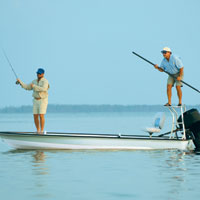Selecting Your Freshwater Fishing Gear
With nearly 45 million Americans listing fishing as their preferred leisure activity, recreational anglers outnumber participants in most other outdoor sports. Successful anglers mix patience, skill, finesse, and sometimes brawn to land their catch. Having the right equipment makes it easier to achieve success and enjoy the sport.
Fishing offers a seemingly endless range of experiences, from the simplicity of a cane pole with canned corn and doughballs on a farm pond, to high-energy, technology-laden bass fishing tournaments that send professional anglers, rich with sponsors, powering after lunker largemouths. The types of fishing that you try, along with the venues you choose, determine the gear that you need. What works in one spot, for one species, may not work down the bay, up the creek, or for another kind of fish. Fly fishing for salmon in Quebec requires different gear than trolling for stripers on Tennessee lakes or casting for smallmouth bass on the Potomac River. Volumes have been, and are still being written about selecting freshwater fishing gear. Regardless the types of fishing you try and the waters you frequent, certain basic criteria hold true.
Fishing Rods, the Essential Tool
In its essence, a fishing rod or a fishing pole is a stick used to dangle a string that terminates in a hook used to catch fish. A modern fishing rod is generally a more sophisticated casting tool fitted with line guides and a reel for storing line. Fishing rods vary in thickness, flexibility, and length, and can be 2 to 20 feet long. The longer the rod, the greater the mechanical advantage in casting.
A fishing rod also extends the angler’s reach and leverage. Essential to casting and presenting the bait or lure to attract fish, the rod absorbs the shock of a fish striking and helps set the hook and play and land the fish. Rods also hold the reel and guide the line on and off the spool.
Rods are generally fitted with guides, wire loops that direct the line to the tip-top, the guide at the top of the rod. Grips are the part of the rod that you hold in your hand, usually made of synthetic EVA foam, or cork on good casting rods. The seat holds the reel, usually using some form of screw ring or lock device.
Use spin casting rods for active styles of fishing where you frequently cast and retrieve the bait or lure. Fly fishing rods are long, thin, flexible, and lightweight, designed to cast a fly usually made from a few wisps of fur, feathers, and foam tied to a hook. Conventional spinning rods are heavier and suited to fishing for larger fish such as striped bass, steelhead, and salmon.
Regardless the type of fishing you enjoy, match your rod, reel and tackle to improve your chances of making a catch. For novices and casual anglers, a prepackaged combination of rod, reel, and tackle enables you to spend more time actually fishing.
Fishing Reels Store, Deploy, and Retrieve
Fishing reels store, deploy, and retrieve fishing line. They increase your mechanical advantage to handle strong fish and have a “drag” system used to pressure a fish during a fight. The first American fishing reel was invented around 1820, a bait caster that quickly became popular. Bait casting reels store line on a revolving spool and are mounted above the rod. Their spools sit perpendicular to the rod and range in size from compact to massive multi-speed offshore saltwater reels. They require a bit more technique when casting to avoid backlash and tangled lines.
- Spinning reels are the easiest for most anglers to use and are suitably robust for most freshwater fishing. They have a fixed spool set below and parallel with the rod and were originally designed to throw artificial flies and lures to trout and salmon. The fixed spool solved the backlash problem and later models proved sturdy enough to handle larger baits and larger catches. Spinning reels are an excellent choice for light tackle and easy to use by casual and beginning anglers.
- The spin cast reel addresses the bait casting reel’s backlash and reduces the line twist and snaring sometimes encountered with spinning reels. Traditionally mounted above the rod, the spin cast reel—sometimes called a closed face spinner--is fitted with a metal cup and an external nose cone enclosing the fixed, parallel spool.
- Fly casting reels are relatively simple and serve more to store the line than to mechanically assist playing the fish.
A rod and reel work together to form a system. Choose a reel is to match the rod you’ll be using. Buying a rod and reel combination can be a wise shortcut to getting yourself out on the water catching fish.
Learn more about gear and find fishing gear manufacturers by visiting our fishing accessories section.
See Also:
- Secret Fishing Tips
- Bass Fishing Tips - 10 Bass Fishing Secrets from the Pros
- 27 Ways To Tell If You’re A Fishing Fanatic
- Trolling Motors
- When To Fish
- Fighting A Fish
- Freshwater Fishing Tips
- Codes of Angling Ethics
- Freshwater Fishing Basics
- Fishing With Kids
- Where Do Fish Live?
- Discover Fishing
- Fishing Tips - Rod Storage
- Fly Fishing Boats
- What’cha Eating? Bait Matrix
- Flyfishing Essentials
- Freshwater Fish - Bass
- Ten Tips for Clean and Green Boating
- Finding the Right Freshwater Fishing Boat for You
- Freshwater Fish - Trout
- Freshwater Fish - Crappie
- Freshwater Fish - Northern Pike
- Fishing Accessories - Tips from the Boating Guy
- Freshwater Fish - Perch
- Choosing the Most Effective Freshwater Fishing Tactics
- Freshwater Fish - Catfish
- Freshwater Fish - Carp
- Selecting Your Freshwater Fishing Gear
- Freshwater Fish - Chain Pickerel
- Freshwater Fish - Walleye
- Freshwater Fish - Eel
- Freshwater Fish - Muskellunge
- Freshwater Fish - Drum
- Boating is Affordable
